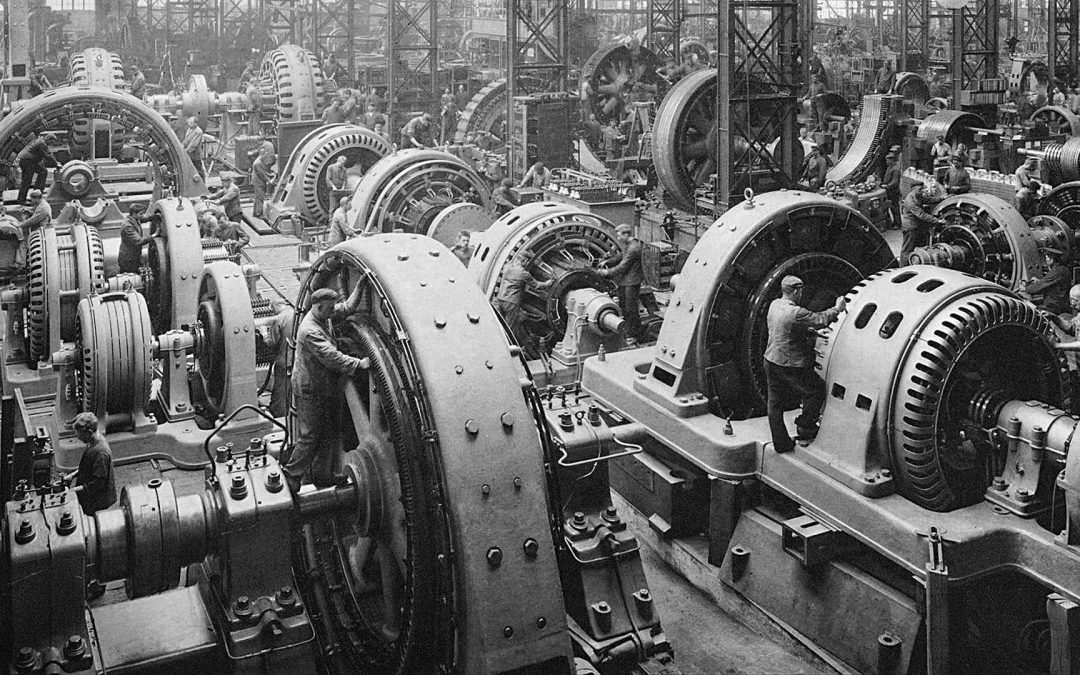
Heavy Metal
AEG Turbinen Fabrik. Deutschland 1950. Do you feel it?

AEG Turbinen Fabrik. Deutschland 1950. Do you feel it?

It was a damp Tuesday evening in London, but they waited down the block and around the corner to get in, mostly young men, mostly in sneakers, at least one with a Supreme bag.
It wasn’t a so-called product drop. It was an opening at the Gagosian Gallery. “We have never had a lineup around the block to get into an exhibition,” said Nick Simunovic, the director at Gagosian Hong Kong.

The occasion was the opening of “Future History,” a collaborative exhibition by Virgil Abloh, the American designer behind Off-White, and Takashi Murakami, the Japanese fine artist whose menagerie of adorable cartoon monsters have become pop totems (and the guest stars on a best-selling line of Louis Vuitton accessories).
Each man is a hero of the “hypebeast” community, and they came together last year at ComplexCon, the annual convention at which hypebeasts swarm. Mr. Abloh and Mr. Murakami had set up a silk-screen station to create T-shirts together and were mobbed.
“I never knew sneakerheads,” Mr. Murakami said of his first time at ComplexCon. “I said, ‘What is happening?’ I am walking around this convention, and everyone knows my face.” He imitated the fanboys he encountered in a gasp: “‘Oh my God, Takashi Murakami, oh my God, oh my God!’” Then he giggled in disbelief: “What?”

ComplexCon had led here to Gagosian, the gallery that represents Mr. Murakami, for which, over the course of about two and a half months, he and Mr. Abloh collaborated on paintings and sculptures. Mr. Murakami made a large sculpture of one of his smiling flower characters; Mr. Abloh built a greenhouse around it. Mr. Abloh requested a screen print of an image from a 17th-century self-portrait by Gian Lorenzo Bernini; Mr. Murakami screened the mouselike ears of his character Mr. DOB on top.
“Truth be told, I don’t go into these things knowing if they’ll work,” Mr. Abloh said.
The day before, Mr. Abloh, in T-shirt and camouflage pants, and Mr. Murakami, in baggy sweats and Off-White Nikes, had installed the show and discussed their working process.
“My position is, he’s the master, I’m the labor,” Mr. Murakami said. They had come together each with their own thoughts and bounced them off each other, and developed ideas quickly.
“From the idea to do the show to what some of these first pieces would be was, maybe, two minutes,” Mr. Abloh said. Both men’s icons are instantly recognizable in each piece — Mr. Abloh’s ever-present air quotes, Mr. Murakami’s characters — but here they’re presented as co-signed artworks, even if Mr. Abloh’s usual media are clothes and shoes.
“When I’m designing a shoe, I’m employing ideas from art, everything I’ve seen, and it’s manifesting itself in a shoe,” he said. “Why not cement them in serious art pieces? That’s what these four walls do, more than a retail store.” He paused at a sculpture of a Murakami character rising off a base made from an Off-White logo mark. “I could see this in a retail space,” he said. “I could also see it in a home of a billionaire.”
It could well end up in one. Even before the exhibition’s opening, half of the pieces had been sold. “The feedback and results have been incredible,” said Mr. Simunovic, the gallery’s liaison to Mr. Murakami. “We sold a painting today, for example, to a 21-year-old who had never worked with the gallery before.” The gallery does not disclose artwork pricing.

For Mr. Abloh, part of the project’s appeal was bringing his dedicated fan base into contact with the new horizons of the art world. In 2019, the Museum of Contemporary Art in Chicago will stage the first museum retrospective of his work. “It’s generational,” he said. “I was born in 1980. I always thought that us buying a rare Supreme shirt is like buying a print for a previous generation.”
Mr. Abloh and Mr. Murakami did design an edition of 400 T-shirts to be sold on the Gagosian website, which will be finished by hand as an entry-level offering; they quickly sold out. But none were for sale the night of the opening, and the lines formed anyway. (Many of those waiting were hoping that the artists would sign their sneakers and shuffled around the gallery, once they were finally let in, in socks.)
Mr. Murakami, who between the installation and the opening had traded his hygienic face mask (he had a slight cold) for one fashioned out of a Nike sneaker, one of Mr. Abloh’s signature zip ties and a bit of camouflage print from his Louis Vuitton collaboration, seemed delighted. He sneaked out of the gallery to take selfies with those waiting. (“How’s the population in London of sneakerheads?” he had wondered in all seriousness the day before. “I really want to welcome the new audience.”)
“The world moves as fast as Instagram scrolls,” Mr. Abloh said. “What excites me more is the physical. I think that will be rewarding. That’s my barometer: Is the piece done? Is it good enough? Is it worthy of someone’s time?”
Outside, they were still waiting. Even Mr. Martin, the marine. “I’m not going to get in,” he said, with admirable even temper. There was over an hour to go. Luckily, the exhibition remains up through April 7.
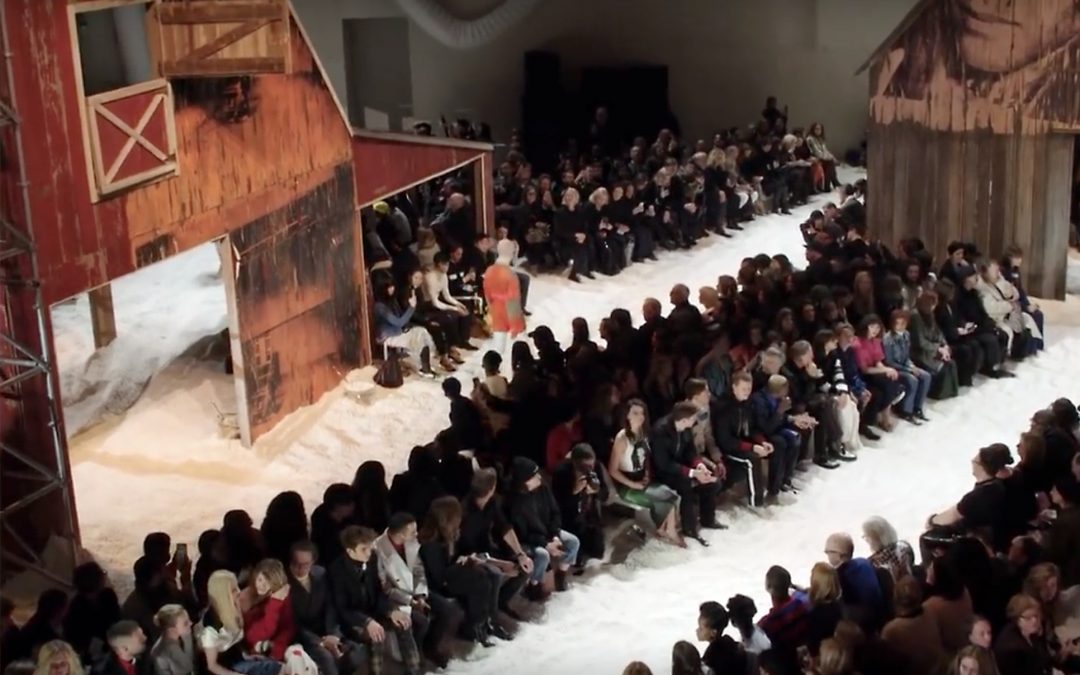
New York Fashion Week finally came to life Tuesday evening in the shadow of the valley of — well, not death exactly. More like a post-apocalyptic prairie seen through a B-movie lens. Toto, what happened to Kansas?
Raf Simons buried it under 50,000 gallons of popcorn.
Or, to be fair, he buried the floor of the American Stock Exchange building under 50,000 gallons of popcorn, trucked in for a wackadoodle Calvin Klein show. It piled up in drifts around the weathered sides of four skeletal barns hung with blood red Sterling Ruby mop heads and papered with spectral black and white Warhol reproductions. It was crushed under the shoes of guests, so little motes of popcorn dust blew through the air. They landed on the coats and skirts and hair of Michael B. Jordan and Nicole Kidman and Millie Bobby Brown (among many other famous people), making everyone look as though they had an unfortunate case of dandruff or had wandered into a Food Channel version of nuclear winter.
Then a model in a bright orange hazmat suit and waders appeared. Let’s rephrase: Welcome to the pop-calypse.
Since he arrived at the brand that bluejeans and minimalism built, Mr. Simons, who is from Belgium, has been fixated on defining his own brand of twisted Americana, largely built on the twin pillars of Laura Ingalls Wilder and “On the Road” (the Netflix versions) — after the rot set in. This season he took it even further, with women in giant tweed coats over sweeping lawn skirts and men in sweater vests that looked more like life vests over skinny suits and shirts buttoned tight to the neck. Everyone wore knit Fair Isle balaclavas and often big firefighters’ gloves in silver foil, which also was used in false-front A-line cocktail dresses trimmed in white lace that turned into camper-blanket sheaths at the back.
Also the two-tone cowboy shirts and placket trousers that Mr. Simons has used in every collection since his Calvin debut, and skinny striped sweaters and sweaters with Wile E. Coyote and the Road Runner knit in, plus apron dresses with nothing underneath, so the breasts were exposed (a strange segue into Naughty Nellie from the general store). Quilting squares were pieced onto crisp white shirts and reworked as bias-cut chiffon evening gowns. The effect was all very survivalist. Simon & Garfunkle’s “Sound of Silence” played in the background. So did “California Dreamin’ ” by The Mamas & The Papas.
It was both a reductionist view of the country’s most accessible myths and also stomach-churningly right. That’s where we are now: drowning in a sea of puffed corn kernels and empty calories, appropriating the appropriators.
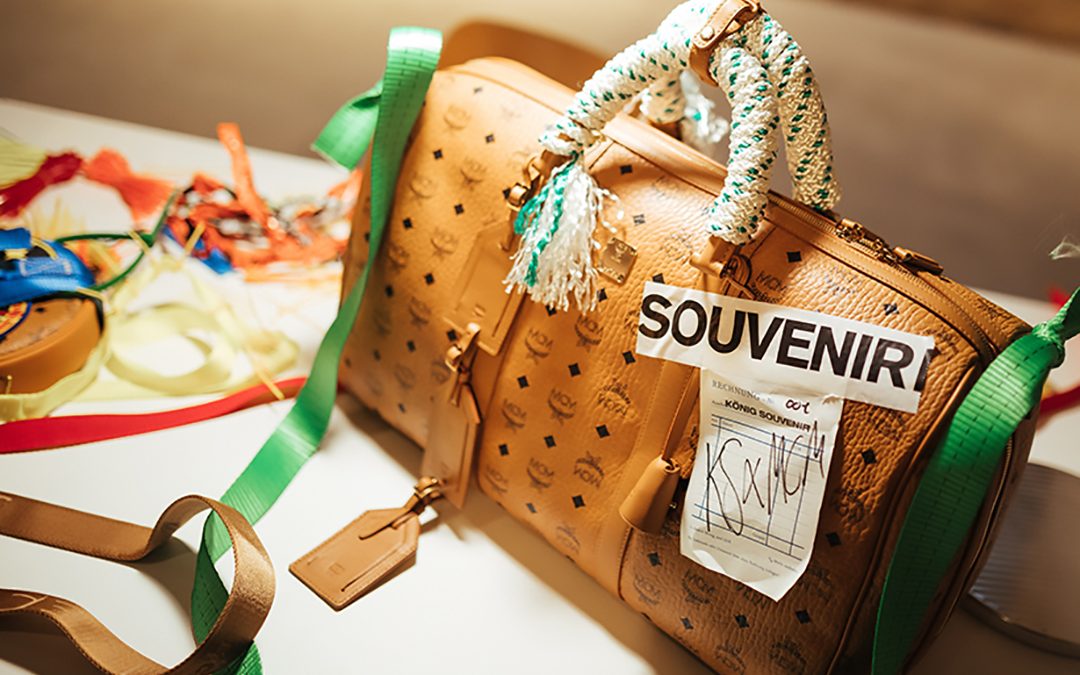
Luxury travel goods manufacturer MCM finds a new Seoul in Berlin.
Everybody is speaking about millenials and Generation Z and it seems that they are responsible for the death of mainstream media with their very niche interests. At Achtung Mode we are highly specialized in fashion content only but more and more the luxury brands we work with have to execute crossover ideas often in conjunction with the art world to have reach. MCM is a leader when it comes to speaking to the fickle millennial audience. And here is why.
Oh boy, all the smart marketing moves they have to come up with to play favor with this audience. They are a shopaholic generation of travelers whose itineraries make those of diplomats pale in comparison and they only want the coolest. They are all over the place and all over the planet and know everything. But as every nomad, they like to belong to a tribe.
MCM is a leader when it comes to speaking to the fickle millennial audience.
If you want to have them buy your product and stay loyal you must make them believe in your roots and heritage and always keep them entertained. Sounds complicated, yes, and it is.
Still MCM, which is considered a hip brand with millenials, has taken a big step a few weeks ago. The brand was born in Munich and is doing well all over Asia for its German craftsmanship and savoir-faire reputation. But to stay on the edge, MCM, which is focusing on growth in Europe and Germany at the moment, has decided to declare Berlin as its new German creative hub with global influence. Munich is in the history books but Berlin and its Bauhaus tradition and now bourgeoning art and club scene is what makes the brand tick. Also, Made in Italy will start playing a bigger role for the brand.
To underline this new direction, MCM’s Sung-Joo Kim invited an eclectic group of international journalists and tastemakers to a few days in Berlin under the moniker Viva MCM, Viva Berlin. Events where kicked off at the Store at Soho House Berlin. The Store has slowly but surely established itself as one of Berlin’s best retail destinations next to the Corner and Andreas Murkudis and the Voo Store with its fine edit of top brands. Korean DJ Peggy Gou played and Berlin DJ trio Fjaak unveiled a USB pocket for MCM with tracks for traveling.
A new collaboration with Johann Koenig Souvenir and MCM which will premier at Art Basel Miami was unveiled.
MCM also organized a tasting menu at Tim Raue, Berlin’s best chef with Asian leanings and highlight was an evening at St. Agnes the Johann Koenig art gallery where Norbert Bisky explained his current exhibition to the audience. Needless to say, the space in the Brutalist church is amazing and other top artists like Anselm Reyle who shows in the same gallery attended. Also, a new collaboration with Johann Koenig Souvenir and MCM which will premier at Art Basel Miami was unveiled. On display was an exclusive preview of the KS x MCM collection of limited MCM editions curated by Koenig Souvenir, a label for unique objects of art founded by Johann Koenig and David Mallon: “For the Koenig Souvenir x MCM Travel Collection, we were inspired by the airport as a place of transition – not only for people, but also for art works traveling around the globe. We wanted a collection that recalls this modern way of travel and shipping, but also connects with art in its production process. The collection will be issued as a limited art edition of six travel items playing on the traditional MCM design,” says Mallon. The collaboration will launch at Art Basel Miami Beach this December.
So if you want to stay in with millennial, have roots, show them and make your branches grow.
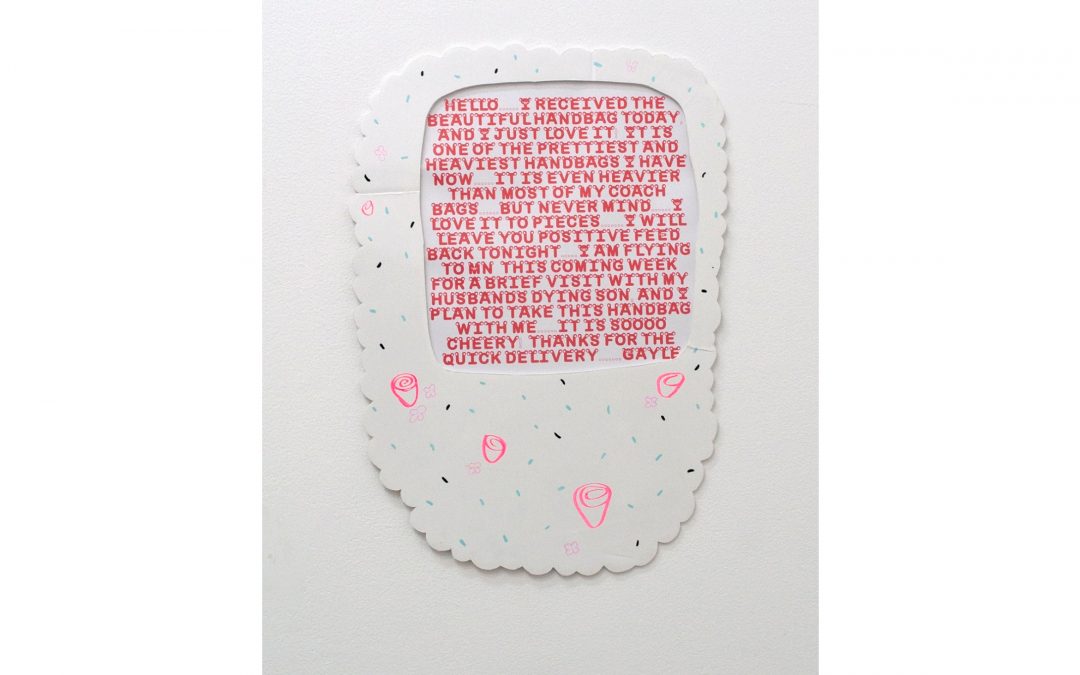
“It starts with a small pink seashell painting and ends with the total rejection of history. Throw a wink in there and you have the tone I’m after.” It’s precisely the pairing of overly pretty aesthetics with acute power plays with dominant art world authorities that have pulled Maddie Reyna to the fore of Chicago’s alternative gallery culture. Last year, Reyna wrote letters to powerful galleries and museums around the country under the nom de plume Casey Goodman to initiate discussions about gender statistics in their exhibition programs. Printouts of the letters were shown at Julius Caesar in East Garfield Park alongside paintings and prints embellished with sweetly hued emoji. One of the ways that Reyna sees power shifting is in the move from attention toward the discrete art object to that of the exhibition, “Questioning these conventions of presentation, the way in which to exert or secede power over your audience became my number-one interest.”
Reyna’s investments in these issues of exhibition and audience aren’t solely those of the studio artist. In 2013, she joined the collective of artists who operate Julius Caesar just as the last of the founding members relocated to New York, and earlier this year a floridly floral installation by artist Chris Edwards inaugurated the new apartment gallery Dreamboat in a spare room of Reyna and
her partner Levi Budd’s Pilsen home. Along with her full-time position at the influential website Contemporary Art Daily, Reyna’s gallery endeavors allow her to explore what she describes as the complex “efforts of a group of people who think strongly, don’t like the same work, and fight hard for its right to have a platform.”
In her studio, Reyna is a shoplifter, an aspiring screenplay writer and a purveyor of saccharine sentimentality. In February at an artist residency in Reykjavik, Iceland, she wrote a screenplay based on a short story her mother wrote at age thirteen in which a class of school kids is murdered in outer space. For the works she’ll exhibit at Roman Susan opening May 9, she’s been shoplifting accessories from Claire’s and Forever21 that will be inset into painted displays. “The accessories I take are always selling an identity and secret ideology to young women… I’m stealing them because I see this act as also an unsuspecting protest of capitalism really fueled by the want of a pretty object.” Roman Susan hosts one of five exhibitions Reyna’s preparing work for this year; her busy schedule is another attempt to complicate what receives attention. (Matt Morris)
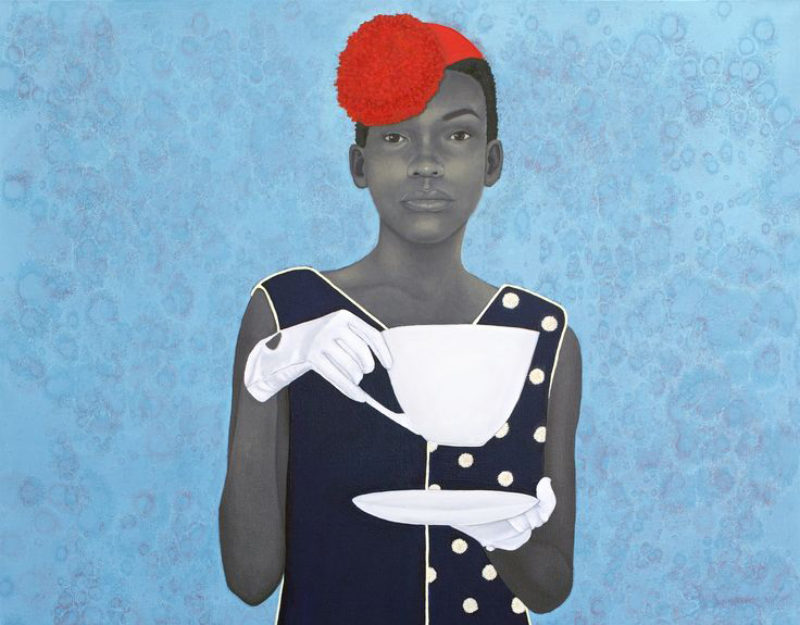
Kehinde Wiley and Amy Sherald have been commissioned to paint former President Barack Obama and former First Lady Michelle Obama’s official portraits for the Smithsonian’s National Portrait Gallery in Washington, DC.
Sherald, 44, specializes in portraits of black women. Although she, too, appreciates bright colors, her cheerful backgrounds and subject’s fashionable clothing contrast with the surreal figures, their skin painted in shades of gray.